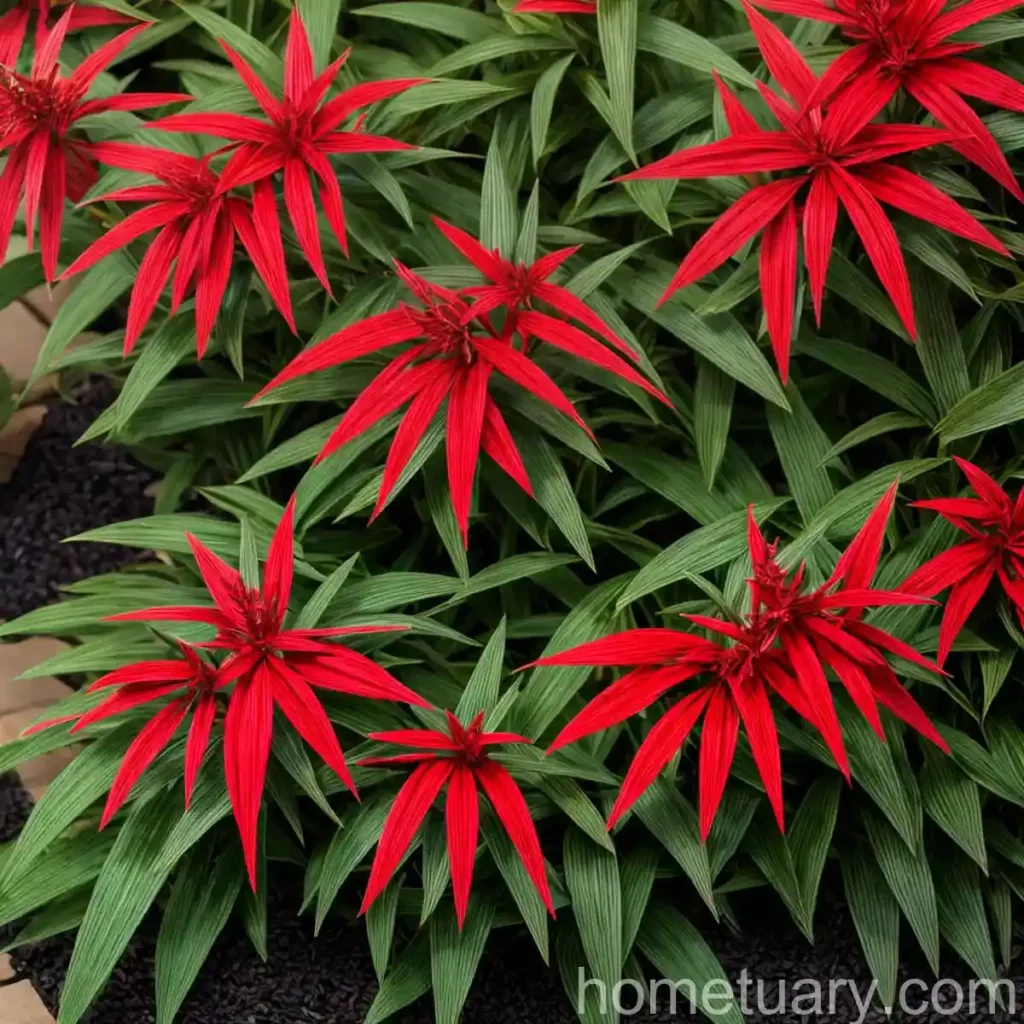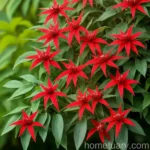Heavenly Bamboo (Nandina domestica ‘Fire Power’)
Heavenly bamboo, scientifically known as Nandina domestica ‘Fire Power’, is a versatile and attractive evergreen plant that adds ornamental value to gardens and landscapes. With its vibrant foliage and low maintenance requirements, this plant has become a popular choice for both professional landscapers and home gardeners. In this comprehensive guide, we will explore the key aspects of heavenly bamboo care, its uses, and strategies for maintaining its health and vitality.
What is Plant? – Heavenly Bamboo (Nandina domestica ‘Fire Power’)
Heavenly bamboo is not a bamboo plant at all. It’s a member of the Berberidaceae family and is characterized by its bamboo-like growth habit and delicate, lacy foliage. The ‘Fire Power’ cultivar specifically is known for its vibrant red foliage that emerges in the spring and persists throughout the year, turning a brilliant red color in the fall and winter. This compact, clumping evergreen shrub is native to eastern Asia, especially Japan, China, and India.
Key Takeaways – Heavenly Bamboo (Nandina domestica ‘Fire Power’)
- Scientific Name: Nandina domestica ‘Fire Power’
- Common Name: Heavenly Bamboo
- Plant Type: Evergreen shrub
- Mature Height: 2 to 4 feet
- Mature Spread: 1.5 to 2 feet
- Growth Rate: Moderate
- Flowering: Small white flowers in late spring to early summer, followed by red berries in the fall
- Foliage: Bright red in spring and fall, transitioning to green in summer
- Hardiness Zones: 6-10
- Exposure: Full sun to partial shade
- Watering: Moderate
- Soil: Well-draining, fertile soil
- Uses: Ornamental specimen, mass planting, borders, and containers
Now, let’s delve into the specifics of caring for and utilizing this versatile plant.
Culture
Uses
Heavenly bamboo can be utilized in various ways in the landscape, thanks to its ornamental foliage and berries. Some common uses include:
- Specimen Plant: The vibrant foliage and compact growth habit make ‘Fire Power’ a standout specimen plant in the garden. It can be used as a focal point or to add visual interest.
- Mass Planting: When planted in groups, heavenly bamboo creates a striking visual impact, especially when the foliage transitions from red to green.
- Borders and Edges: The mounding growth habit and changing foliage colors make it an excellent choice for borders and edges along pathways and garden beds.
- Containers: ‘Fire Power’ can be grown in containers on patios, decks, or balconies, providing a pop of color and texture in small spaces.
Water
Heavenly bamboo generally has moderate water needs. When establishing new plants, regular watering is essential to help the root system develop. Once established, the plant is relatively drought-tolerant but will benefit from occasional deep watering, particularly during prolonged dry spells. However, it’s important to ensure that the soil has good drainage to prevent waterlogged conditions, which can lead to root rot.
Sunlight
‘Fire Power’ heavenly bamboo thrives in full sun to partial shade. In regions with hot summers, providing some afternoon shade can help prevent leaf scorch. In contrast, insufficient sunlight can result in poor foliage coloration and reduced flowering and berry production.
Fertilizer
Heavenly bamboo generally does not have high fertilizer requirements, especially if grown in fertile soil. A balanced, slow-release fertilizer applied in early spring can provide the necessary nutrients for healthy growth and vibrant foliage. It’s important to follow the specific instructions on the fertilizer package to avoid over-fertilization, which can lead to excessive vegetative growth at the expense of flowering and fruiting.
Soil
The ideal soil for heavenly bamboo is well-draining and rich in organic matter. It thrives in slightly acidic to neutral soil pH and benefits from a layer of organic mulch to conserve soil moisture and regulate soil temperature. While it can tolerate various soil types, ensuring good drainage is essential to prevent waterlogged conditions.
Pruning
Pruning is an essential aspect of heavenly bamboo care, helping maintain the plant’s desired shape, promote air circulation, and rejuvenate older specimens. Here are some key considerations for pruning ‘Fire Power’ heavenly bamboo:
- Deadheading: Removing spent flowers can prevent the plant from allocating resources to seed production, encouraging it to redirect its energy towards growth and foliage production.
- Thinning: Periodic thinning of older growth and overcrowded stems can help maintain an open growth habit and improve air circulation, reducing the risk of disease.
- Rejuvenation: If the plant becomes leggy or overgrown, it can be pruned back quite severely, typically in late winter or early spring, to stimulate new growth and restore a more compact form.
Propagation
Heavenly bamboo can be propagated through several methods, including seed propagation, division, and stem cuttings. While ‘Fire Power’ is primarily propagated through stem cuttings to ensure the retention of its unique characteristics, division can also be effective for older plants that have developed multiple clumps. Propagating from seed can also yield new plants, but the resulting seedlings may not necessarily exhibit the exact traits of the parent plant, especially in the case of cultivars like ‘Fire Power’.
Container Popularity
The compact size and attractive foliage of ‘Fire Power’ make it well-suited for container cultivation. Here are some considerations for growing heavenly bamboo in containers:
- Container Selection: Choose a large container with adequate drainage holes to ensure proper water drainage. A soil-rich mix with good moisture retention properties is ideal for potted heavenly bamboo.
- Patio and Balcony Decor: Placing containers of ‘Fire Power’ on patios, decks, or balconies can add color and texture to outdoor living spaces, enhancing the overall aesthetic.
- Versatile Placement: Containers of heavenly bamboo can be moved around to create different garden arrangements, and they also allow flexibility in overwintering in regions with cold winters, as they can be brought indoors when necessary.
Common Diseases
Heavenly bamboo is relatively resistant to most diseases, but it can occasionally experience issues such as leaf spots, powdery mildew, and root rot in poorly drained soils. Here are some common diseases that can affect ‘Fire Power’ heavenly bamboo:
- Leaf Spots: Fungal leaf spot diseases can occur, causing unsightly browning or spotting of the foliage. Good air circulation and avoiding overhead watering can help prevent these issues.
- Powdery Mildew: In conditions of high humidity and poor air circulation, powdery mildew can develop, leading to the characteristic white powdery growth on the leaves. Fungicides and cultural practices that promote air movement can aid in prevention.
- Root Rot: Overly wet or poorly drained soil can lead to root rot, which may manifest as yellowing or wilting foliage. Correcting drainage issues and avoiding overwatering can help prevent this problem.
Disease Diagnosis
Diagnosing diseases in plants, including heavenly bamboo, involves careful observation of the symptoms and signs present. Here are some general steps for diagnosing plant diseases:
- Symptom Identification: Identify the specific symptoms, such as discoloration, spots, wilting, or unusual growth patterns, on the foliage, stems, or roots.
- Signs of Pathogens: Look for signs of pathogens, such as fungal spores, bacterial ooze, or insect activity, which can provide clues about the nature of the disease.
- Environmental Conditions: Consider the prevailing environmental conditions, including temperature, humidity, and soil moisture, which can influence disease development.
- Consultation: If unsure about the diagnosis, consult with local horticultural experts or extension services to identify the specific disease and develop a management strategy.
Common Pests
Heavenly bamboo is relatively resistant to most pests, but it can occasionally face attacks from insect pests such as aphids, scale insects, and spider mites. Here are some common pests that can impact ‘Fire Power’ heavenly bamboo:
- Aphids: These small, sap-feeding insects can congregate on the stems and foliage of heavenly bamboo, causing distortion and stunted growth. Insecticidal soaps or horticultural oils can be effective in controlling aphid populations.
- Scale Insects: Scale insects can appear as small, immobile bumps on the stems and foliage, feeding on the plant’s sap. Systemic insecticides and horticultural oils can be used to manage scale infestations.
- Spider Mites: These tiny pests can cause stippling and webbing on the foliage, impacting the plant’s overall health. Water sprays and insecticidal soaps can help control spider mite populations.
Botanist’s Tips
As a plant scientist specializing in ornamental plants, including heavenly bamboo, I would like to offer the following tips for successful cultivation and management of ‘Fire Power’ heavenly bamboo:
- Cultural Practices: Good cultural practices, including proper watering, adequate sunlight, and regular maintenance, are key to promoting the health and vigor of heavenly bamboo.
- Integrated Pest Management: Implementing an integrated pest management approach, including monitoring for pests, encouraging natural predators, and using targeted control methods, can help maintain plant health without excessive reliance on pesticides.
- Soil Management: Soil quality and drainage play a vital role in the performance of heavenly bamboo. Regular soil testing and amendments can help create an optimal growing environment for the plant.
- Pruning Timing: Understanding the best timing and techniques for pruning heavenly bamboo is important to maintain its desired form and encourage robust growth.
- Strategic Placement: Consider the plant’s mature size and growth habits when selecting its planting location to ensure it has adequate space to thrive.
Fun Facts
- The name “heavenly bamboo” is derived from the plant’s visual resemblance to true bamboo and its ornamental qualities.
- Heavenly bamboo is not a true bamboo and is instead closely related to barberry shrubs.
- The red berries produced by heavenly bamboo are toxic to humans but are attractive to birds, serving as a food source for wildlife.
- In Japanese folklore, heavenly bamboo is believed to ward off evil spirits and is often planted near entrances for protection.
Links to External Resources
To further enhance your knowledge and understanding of heavenly bamboo, I recommend exploring the following resources:
- Nandina domestica – University of Florida Extension
- Heavenly Bamboo – University of California Agriculture and Natural Resources
- Planting and Care of Nandina – Clemson Cooperative Extension
- Heavenly Bamboo in the Landscape – University of Arkansas Division of Agriculture
In conclusion, heavenly bamboo, particularly the ‘Fire Power’ cultivar, offers a combination of vibrant foliage, year-round interest, and adaptability, making it a valuable addition to diverse landscapes and garden settings. By providing the right cultural conditions, addressing common plant health concerns, and appreciating its ornamental attributes, gardeners can enjoy the beauty and resilience of this distinctive ornamental shrub. Whether used as a focal point, border planting, or container specimen, ‘Fire Power’ heavenly bamboo adds ephemeral charm to outdoor spaces, captivating the eye and uplifting the spirit with its fiery hues and graceful form.















